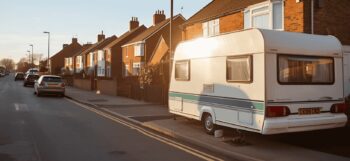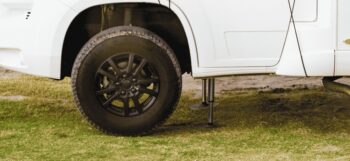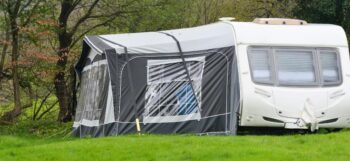Following our article last October about preventing and treating damp in caravans, we have had a request for some similar information specific to motorhomes. Due to the similarity between caravans and motorhomes, much of the advice and information will apply equally to both vehicles, however, this article will also cover some motorhome-only points.
Preventing damp and related issues
As always, prevention is better than cure, and it is far easier to do what you can to stop damp, mildew and mould setting in than it is to get rid of them once they’ve found a new home. Following these steps will help to prevent that nightmare from becoming your reality:
- Clean and vacuum the entire interior of your motorhome regularly. Wipe down all surfaces with an anti-bacterial or disinfectant product and make sure everything is properly clean and dry before you lock up again.
- Don’t leave your motorhome locked up for lengthy periods of time. Even if you won’t be using it for a few months, remember to visit and let some air circulate every now and again.
- No matter how well you’ve cleaned your motorhome before the off-season, give it a thorough clean again before you use it. Don’t forget the exterior, and all the various nooks and crannies.
- Always open the bathroom and kitchen windows as much as possible, particularly straight after the shower or oven have been used. Don’t let moisture build up.
- Check often for any signs of leaks, damaged seals or other issues (no matter how small) which could allow moisture, bacteria and fungus to collect and breed.
- Regularly check that the hose clips around pipes are secure.
- Softened walls are a common sign of damp – if you notice them in your motorhome, contact a professional immediately to have the problem rectified.
- Don’t forget about your cupboards – clean inside all cabinets, wardrobes and other storage units regularly and dry completely before replacing contents.
- If something gets spilled or water is splashed in the kitchen or bathroom, always clean it immediately.
- Wipe condensation from the windows and doors as soon as you spot it.
- If any soft furnishings, carpets, cushions or other materials get wet to the point of being unable to dry, remove and replace immediately. Any soft furnishings and bedding which have been stored should be checked carefully before using again.
- If any areas of your motorhome are particularly prone to moisture, use dehumidifying crystals and other moisture control products to keep it to a minimum.
- Clean again before the end of each motorhome break you take.
- Have your motorhome resealed regularly to avoid leaks and condensation. An annual service should include this, perhaps as an additional option. It is always advisable to request a check and replacement of worn seals if not offered as standard.
- Have roof joints resealed at least once every three years, to prevent damage to the side panel joints and timber construction.
- If your motorhome suffers any bumps or scratches, make sure to have them repaired as soon as possible. As well as the aesthetic aspect, any break in the exterior surface can allow moisture to penetrate.
- Avoid using jet washers, power washers and powerful hoses to wash your motorhome, as these can cause damage to external surfaces and force water into tiny gaps.
Basically, the best way to keep your motorhome free of damp, mould and mildew is to keep it clean and dry at all times
Recognising the signs of damp
No matter how careful you are, your motorhome could still be susceptible to damp and the associated problems. Learning to recognise the signs of damp is essential and will enable you to deal with the problem swiftly.
- Musty smell on entering the motorhome
- Black marks around windows or doors, or on walls
- Staining on walls
- Walls which feel soft when pressed with fingertips
- Damp-looking patches on walls or ceilings
The most reliable way to check for damp is to invest in a damp meter. These can be purchased relatively cheaply from hardware stores, eBay and similar outlets and are great at detecting the early signs of damp. The cost of investing in one of these meters will be significantly less than the cost of repairing a damp problem in the future, so we can highly recommend it.
As with any other item of equipment you may need, damp meters are available in a range of options (and prices). The Aldi version tends to get good reviews, so keep an eye out on their weekly deals if you have a store nearby – you may be lucky and see them reappearing before your next break.
When using the meter, remember to check in the hidden corners where damp is likely to appear – it is more likely to appear under the rubber sealing around a window than in the centre of a wall, for example. Liquid can also travel along the outside of wires and pipes, especially when your motorhome is on the move.
If you, or a previous owner, have made any DIY changes to your motorhome such as adding a bike rack or satellite dish, check around the fixing holes too.
Damp meter readings fall into the following categories:
0-15% - no cause for concern
15-20% - professional investigation required
21-30% - remedial action possibly required. Motorhome may show signs of damp or water ingress
Over 30% - severe structural damage may be occurring
Also remember that, no matter how small a damp reading is, it can potentially cause huge problems if left untreated so always investigate and seek professional assistance if required.
If you are not confident about doing the checks yourself, many dealerships will carry out damp checks for a charge as part of their aftersales service. Phoning or emailing local dealerships will give you a better idea of what this will cost, but prices tend to be around £150 for a very thorough inspection.
Water Ingress
If you suspect that your motorhome has water ingress in any of the panels or floor it is best to consult a professional. If you spot water pooling on the roof of your motorhome, it is a good idea to park it on ramps, if possible, to prevent the problem worsening while you wait for the specialist to arrive.
There is no quick fix for water ingress and an engineer will be able to assess the extent of the damage and advise on the best course of action, as it is possible that specialist equipment will be needed to remedy the problem.
Your local dealership should be able to point you in the right direction if they are unable to deal with the problem themselves.
Removing mould and mildew
Make sure to wear appropriate protective clothing before you start dealing with damp, mould or mildew (just have a look at the section on the health risks if you don’t think it’s necessary). This should include decent gloves, a face mask and an apron or overalls.
- Never use bleach to clean up. Use either a solution of washing up liquid and warm water, or a mixture of one part vinegar to one part warm water to deal with the mould and mildew.
- Use a scrubbing brush to thoroughly clean the affected areas
- Dry completely
- Fill a spray bottle with a mixture of 1 tablespoon of clove oil to 1 litre of water and apply to the affected areas to stop the damp from returning. Wipe off and dry after twenty minutes.
- If the mould and mildew are particularly bad or recurrent, it is well worth investing in the services of a professional to sort the problem properly
- Once you have cleared the mould and mildew, remember to follow the steps we gave for preventing the issue.
Health risks associated with damp, mould and mildew
Many people underestimate the potential health problems caused by the presence of damp, mould and mildew, but the truth is that they can have a very serious effect on health, particularly in small children, the elderly and others with underlying health conditions.
The following are some of the most common health risks associated with damp:
- Allergic reactions caused by inhaling spores
- Those with asthma can experience asthma attacks or even added complications if mould and mildew spores are breathed into the lungs
- People with weakened or compromised immune systems can be susceptible to lung infections when exposed to damp, mould and mildew
- It’s not all about physical symptoms – mental health can also be affected. Some proven effects include memory loss, mood swings, chronic fatigue and migraines. Nothing particularly pleasant, we’re sure you will agree!
- The skin is also prone to reacting to damp and spores – hives, skin rashes, eczema, bacterial infections and fungal infections are all possible
If you have any tips for dealing with damp please tell us about them in the comments below.
Don't forget to give us a call when your motorhome insurance is due. As a specialist broker with over 45 years experience we have top quality policies that protect you when you need it most. Call us on 01480 402460 for a no-obligation quote.











